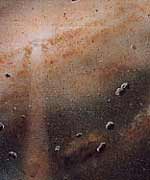
Image credit: William K. Hartmann/PSI
The oxygen and magnesium content of some of the oldest objects in the universe are giving clues to the lifetime of the solar nebula, the mass of dust and gas that eventually led to the formation of our solar system.
Specimen from the Allende Meteorite
By looking at the content of chondrules and calcium aluminum-rich inclusions (CAIs), both components of the primitive meteorite Allende, Lab physicist Ian Hutcheon, with colleagues from the University of Hawaii at Manoa, the Tokyo Institute of Technology and the Smithsonian Institution, found that the age difference between the two fragments points directly to the lifetime of the solar nebula.
CAIs were formed in an oxygen-rich environment and date to 4.567 billion years old, while chondrules were formed in an oxygen setting much like that on Earth and date to 4.565 billion, or less, years old.
?Over this span of about two million years, the oxygen in the solar nebula changed substantially in its isotopic makeup,? Hutcheon said. ?This is telling us that oxygen was evolving fairly rapidly.?
The research appears in the April 21 edition of the journal Nature.
One of the signatures of CAIs is an enrichment of the isotope Oxygen 16 (O-16). An isotope is a variation of an element that is heavier or lighter than the standard form of the element because each atom has more or fewer neutrons in its nucleus. The CAIs in this study are enriched with an amount of O-16 4 percent more than that found on Earth. And, while 4 percent may not sound like much, this O-16 enrichment is an indelible signature of the oldest solar system objects, like CAIs. CAIs and chondrules are tens of millions of years older than more modern objects in the solar system, such as planets, which formed about 4.5 billion years ago.
?By the time chondrules formed, the O-16 content changed to resemble what we have on Earth today,? Hutcheon said.
In the past, the estimated lifetime of the solar nebula ranged from less than a million years to ten million years. However, through analysis of the mineral composition and oxygen and magnesium isotope content of CAIs and chondrules, the team was able to refine that lifespan to roughly two million years.
?In the past the age difference between CAIs and chondrules was not well-defined,? Hutcheon said. ?Refining the lifetime of the solar nebula is quite significant in terms of understanding how our solar system formed.?
Founded in 1952, Lawrence Livermore National Laboratory has a mission to ensure national security and apply science and technology to the important issues of our time. Lawrence Livermore National Laboratory is managed by the University of California for the U.S. Department of Energy’s National Nuclear Security Administration.
Original Source: LLNL News Release
